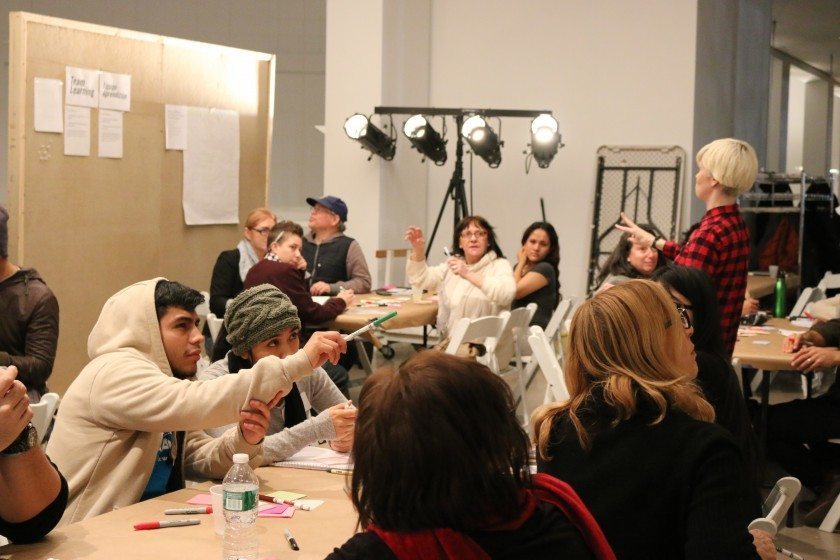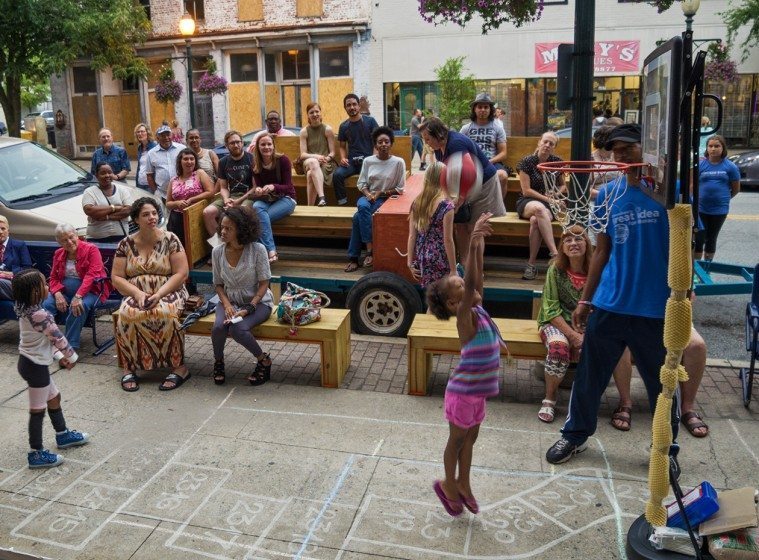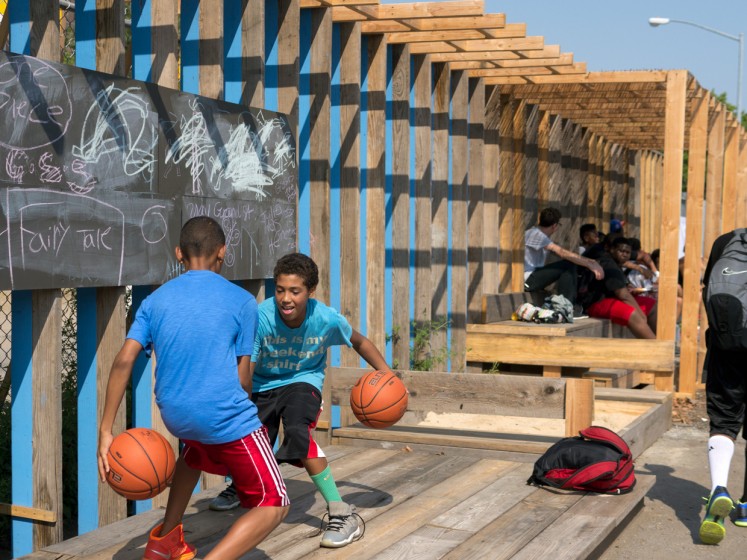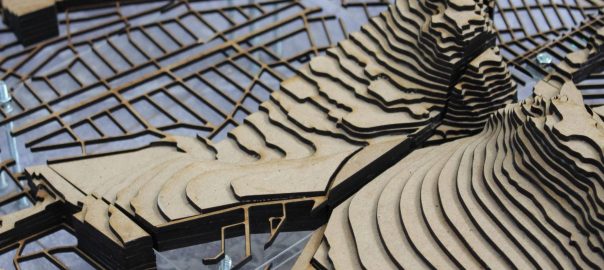We’ve seen a surge in new open space design initiatives here in New York City in the past decade, with projects as big and bureaucratically complex as the 2,200-acre Fresh Kills Park on Staten Island and as small and locally focused as the Bedford-Stuyvensant Community Garden in Brooklyn. Many of these initiatives are designed to make New York City more environmentally sustainable and ecologically resilient in response to the disturbances that will come with a warming climate.
But much of what passes for examples of “ecological,” or “sustainable,” or even “resilient” design in cities makes it seem as if the ideal urban landscape is one that resembles a post-apocalyptic Eden made perfect by the absence of actual human beings. When people do pop into these beautifully rendered images, they often look as if they just finished hiking the Appalachian Trail or rafting the Colorado River. They’re outdoorsy, effervescent, and earnest. There’s no sign of the frazzled morning commuter ascending from an overcrowded morning metro ride, or the disheveled pedestrian jumping over black pools of melting sidewalk snow. No anger or irony or humor. No graffiti. No panhandlers or pizza rats. No street meat vendors or aluminum can scavengers or cops giving teenagers a hard time for sneaking a toke of weed behind the bus stop. No humanity.

Nature, it seems to me, is an impoverished source of inspiration for the design of urban landscapes. We think of nature as something out there beyond the boundaries of human culture, a standard for how things ought to be that both predates and excludes people. Nature, in this sense, derives its authority from its essential lack of humanity. It sits in judgment apart from the messiness of human life. It bears the responsibilities of a god, and all of its pronouncements from on high seem to tell us that the solutions to our problems can be found in abandoning our humanity, retreating from society to find holiness in the purity of streams and meadows, forests and mountains.
This deity we call Nature really doesn’t like cities, and when pressed to come up with something useful to say about careful urban design, its dismissive response is, invariably, “Make them in my image.” Nature, though, is what we make of it. “Our experience of nature is rarely direct,” the geographer Noel Castree reminds us. “Rather, it is thoroughly mediated for us.” The wisdom we claim to find in nature is really a refraction of our own culture—our hopes, anxieties, prejudices and beliefs bounced back at us from the horizon of our limited understanding. Nature, by definition, has no language. Or, put another way, Nature does not speak in any language humans will ever understand on its own terms. We are the wizards behind the curtain, pulling levers and talking into a megaphone to make an otherworldly Nature talk. The real trick, though, lies in convincing ourselves that the rumbling voice we hear is not our own.

None of this is to say that cities don’t need functional green space or that designers shouldn’t be conscious of environmental concerns. Parks and gardens and trees are essential building blocks in cities, both aesthetically and because of the ecosystem services they provide. And landscape architects, urban designers, engineers, and planners of all stripes have much to learn from mimicking the technics of environmental processes. But in both cases, we’re talking about applying good design practices to urban problems—a thoroughly cultural process, no matter what inspiration we draw from that tangle of concepts and creatures we persist in bundling under the heading of “nature.”
Where do we turn to discover good design processes? We turn to good designers. Let’s consider, as an example, the design processes of Charles and Ray Eames, the mid-20th century husband-and-wife architect-and-painter team that put research, learning, and holistic thinking at the center of their practice. You won’t find much having to do with unspoiled nature in the Eames design archives, but you’ll find plenty of projects tackling breathtaking concepts in science, engineering, and technology—all branches of knowledge at the core of any effort to create more sustainable cities. You’ll also find a sincere appreciation for the simple beauty of living things, for things that grow and change, for leaves and flowers, trees and tumbleweeds. Nature isn’t absent in their design, but it’s never intended as a replacement for design.
There was nothing Ray and Charles seemed to love more than a solving a puzzle—other than explaining the solution and its underlying logic afterward. They were humanists, through and through, betraying a love for every dimension of human culture in their educational films, covering topics that included tops and trains and trigonometry. Charles once made a short film that investigated the flow of sudsy water washing across the surface of a blacktop playground, just because the patterns of movement fascinated him. They loved the stuff of daily human life, the stuff Charles named “The New Covetables” in a lecture at Harvard in 1981: bolts of wool and spools of twine and reams of unused paper, all made valuable by their unreleased creative potential. Ray and Charles were also inveterate aphorists, leaving behind a trove of pithy slogans and sayings about design that give us a peek into their creative process and what it has to say to contemporary urban designers and landscape architects in search of a more sustainable future. Here are just two to get started.

“Eventually everything connects—people, ideas, objects. The quality of the connections is the key to quality per se.”
Charles and Ray were “systems thinkers” before there was a popular phrase to describe that way of looking at the world. They were ecologists in the sense that they were sensitive to connections, seeking out surprising links between seemingly unrelated “people, ideas, objects” and exploiting those connections to arrive at better design. Urban designers and landscape architects won’t create more sustainable cities by simply filling every downtown with more trees and grasses and greenery. They need to take the time to consider the emergent and unintended consequences of their designs—how “everything eventually connects.”
Take the case of Los Angeles, where an ambitious “Million Trees” planting campaign initiated by former mayor Antonia Villaraigosa came up nearly 600,000 saplings short by the end of the mayor’s second term in office in 2013. In arid cities like LA, costly investments in lush greenery can make the landscape less sustainable over the long term by making them less resilient in the face of drought and more reliant on water piped in from far-off sources. “By ignoring these technical details,” wrote one local critic, “The Villaraigosa program evokes an earlier generation’s deliberate rejection of environmental realities in favor of imported cultural norms.” And yet it was all done under the guise of “bringing nature back” to the city, as one community group involved in the project claimed.
“Take your pleasure seriously.”
Ray and Charles Eames were playful in their approach to working through design challenges. They loved children’s toys and circuses and every day they hosted a picnic on the lawn behind their sunny Los Angeles studio. “Take your pleasure seriously,” they admonished other designers, inviting them to find joy and satisfaction in complex projects that could demand iteration after iteration of backbreaking failure before arriving at a winning solution.

Nothing dour ever came out of the Eames studio at 901 Washington Boulevard in the quirky, seaside neighborhood of Venice. Compare the colorful cacophony of an Eames design (be it a bookcase paneled in bright primary colors or a thirteen-minute seven-screen multi-track film about life in the United States in the 1950s) to the flinty renderings of new parks and open space projects that unspool from so many large-format plotters in design firms across the land. These designers certainly take their work seriously, but there’s little evidence of any pleasure in the product. Urban design and landscape architecture in the service of sustainable cities need to make space for solutions that pop up from having a healthy dose of wild fun. For example, check out studios like the Hester Street Collaborative in New York City’s Lower East Side or recent work from designers like Chat Travieso, Sarah Lidgus, or Sam Holleran for an idea of what this joyful approach to crafting sustainable and inclusive cities could look like. Lively, participatory, and grounded in local culture, the work produced by these designers often concerns itself with nature in cities, but doesn’t assume that nature is the antidote to urban life. Instead, Chat, Sarah, Sam, and the growing team at Hester Street all start from the core belief that cities are beautiful and worth celebrating. The rest flows from there.
* * * * *
Urban designers and landscape architects can’t ignore human culture in their efforts to make environmentally innovative cities. Every attempt to turn to nature for broad brushstroke solutions is really a turn toward a particular idea of nature—nature as the absence of human intention, human meddling, human design. Yet design is inevitable, even if we’re talking about the design of trees and grasses and greenery, and even the most conservative urban conservation project can never actually put things back they way the were before humans showed up. There is no way to go but forward. “We are as gods,” Stewart Brand likes to say. “We might as well get good at it.”
Philip Silva
New York City











Excellent article, thank you for your eloquent and accessible summation of some complex issues. Anyone interested in further exploring some of these notions of nature would probably enjoy Daniel Botkin’s “dischordant harmonies” in which he observes that our conceptions of Nature, as well as the entire history of scientific inquiry is deeply steeped in metaphor, and reflects our cultural baggage more than we’re willing to admit.
Hola Felipe, que interesante reflexión del paradigma de la naturaleza en la ciudad. Saludos desde Chile, .